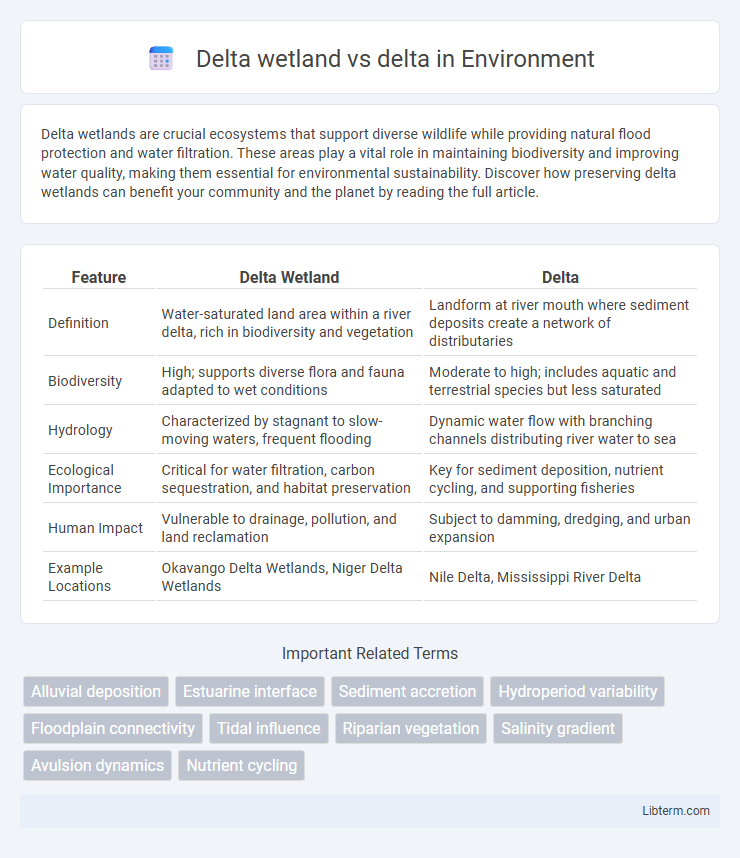Delta wetlands are crucial ecosystems that support diverse wildlife while providing natural flood protection and water filtration. These areas play a vital role in maintaining biodiversity and improving water quality, making them essential for environmental sustainability. Discover how preserving delta wetlands can benefit your community and the planet by reading the full article.
Table of Comparison
| Feature | Delta Wetland | Delta |
|---|---|---|
| Definition | Water-saturated land area within a river delta, rich in biodiversity and vegetation | Landform at river mouth where sediment deposits create a network of distributaries |
| Biodiversity | High; supports diverse flora and fauna adapted to wet conditions | Moderate to high; includes aquatic and terrestrial species but less saturated |
| Hydrology | Characterized by stagnant to slow-moving waters, frequent flooding | Dynamic water flow with branching channels distributing river water to sea |
| Ecological Importance | Critical for water filtration, carbon sequestration, and habitat preservation | Key for sediment deposition, nutrient cycling, and supporting fisheries |
| Human Impact | Vulnerable to drainage, pollution, and land reclamation | Subject to damming, dredging, and urban expansion |
| Example Locations | Okavango Delta Wetlands, Niger Delta Wetlands | Nile Delta, Mississippi River Delta |
Introduction to Deltas and Wetlands
Deltas are landforms formed at the mouths of rivers where sediment accumulates as the river flows into a standing body of water, creating diverse ecosystems. Delta wetlands refer to the specific wetland areas within these deltas, characterized by saturated soils, unique hydrology, and vegetation adapted to fluctuating water levels. These delta wetlands provide critical habitats for wildlife, act as natural water filters, and help in flood control by absorbing excess water during high flows.
Defining Delta Wetlands vs. Standard Deltas
Delta wetlands are specialized ecosystems located within river deltas, characterized by saturated soils, diverse vegetation, and unique hydrological dynamics that support rich biodiversity. Standard deltas refer to the landforms created at river mouths where sediment deposition occurs, typically featuring distributary channels and alluvial deposits but not necessarily encompassing wetland habitats. Delta wetlands function as crucial buffers for flood control, nutrient cycling, and habitat provision, setting them apart ecologically from the broader geomorphological definition of standard deltas.
Formation Processes of Deltas
Delta formation involves sediment deposition where a river meets a standing body of water, creating fan-shaped landforms through sediment accumulation. In contrast, wetlands within a delta form from waterlogged soils influenced by fluctuating water levels, where organic matter accumulates and vegetation thrives in saturated conditions. The differing sediment dynamics and hydrology between delta plains and delta wetlands shape their unique ecological structures and processes.
Ecological Functions of Delta Wetlands
Delta wetlands provide critical ecological functions such as nutrient cycling, water filtration, and habitat provisioning for diverse aquatic and terrestrial species, enhancing biodiversity and ecosystem resilience. These wetlands act as natural buffers that absorb floodwaters, reduce erosion, and improve water quality by trapping sediments and pollutants before they reach the delta's open waters. In contrast to the broader delta region, delta wetlands play a specialized role in supporting fisheries, carbon sequestration, and sustaining migratory bird populations, making them indispensable for maintaining environmental health and productivity.
Sedimentation and Hydrology Differences
Delta wetlands exhibit slower sedimentation rates compared to traditional deltas due to their unique hydrology characterized by reduced flow velocity and periodic inundation. Sediment accumulation in delta wetlands is influenced by organic matter deposition and plant root stabilization, contrasting with deltas where fluvial sediment transport dominates. Hydrological differences include delta wetlands experiencing more stable water levels with seasonal flooding, while deltas often display dynamic channel shifts and tidal influences affecting sediment distribution.
Biodiversity in Delta Wetlands vs. Deltas
Delta wetlands harbor significantly higher biodiversity than typical deltas, providing critical habitats for diverse flora and fauna adapted to fluctuating water levels and nutrient-rich sediments. These wetlands support numerous endemic species, migratory birds, and aquatic life forms due to their complex hydrological dynamics and vegetation structures. In contrast, deltas often experience habitat fragmentation and reduced species richness from urbanization and agricultural expansion, limiting their ecological complexity.
Human Impact on Deltas and Their Wetlands
Human activities such as dam construction, urbanization, and agriculture have significantly altered sediment flow and water quality in delta wetlands, leading to habitat loss and reduced biodiversity. Pollution and land reclamation intensify these impacts by degrading the wetland ecosystems that serve as critical buffers against floods and storm surges in delta regions. Efforts to restore delta wetlands focus on sustainable water management and conservation practices to mitigate the adverse effects of human impact on these vulnerable environments.
Climate Change Effects on Delta Systems
Delta wetlands serve as vital buffers that absorb floodwaters and sequester carbon, enhancing resilience to climate change impacts on delta systems. Rising sea levels and increased storm frequency threaten delta wetlands by accelerating erosion and saltwater intrusion, compromising their ecological functions. Protecting and restoring delta wetlands is critical to mitigating climate change effects, maintaining biodiversity, and sustaining livelihoods in vulnerable delta regions.
Delta Wetland Conservation Strategies
Delta wetland conservation strategies focus on preserving biodiversity, enhancing water quality, and mitigating flood risks by restoring natural hydrology and controlling invasive species in wetland ecosystems. These approaches include sustainable water management, reforestation, and community-based monitoring programs to maintain habitat integrity and support wildlife populations. In contrast, traditional delta management often prioritizes agricultural and urban development, which can lead to habitat loss and ecosystem degradation.
Conclusion: Key Differences and Importance
Delta wetlands are unique ecosystems characterized by rich biodiversity and critical habitats formed by sediment deposits at river mouths, while general deltas primarily describe the landform created by sediment accumulation. The key differences lie in ecological function, with delta wetlands supporting diverse flora and fauna and offering flood control, compared to deltas which are primarily geographic features influencing soil fertility and land formation. Understanding these distinctions is crucial for conservation efforts, sustainable land use, and maintaining natural water filtration and flood mitigation services.
Delta wetland Infographic

 libterm.com
libterm.com